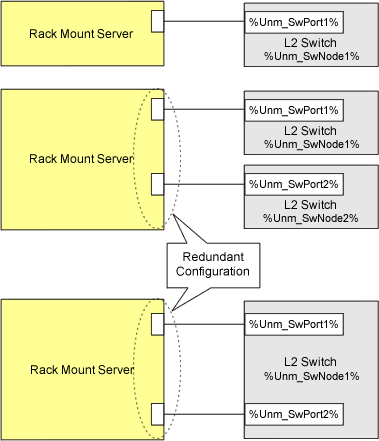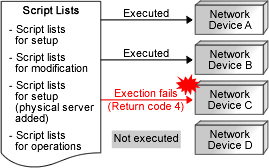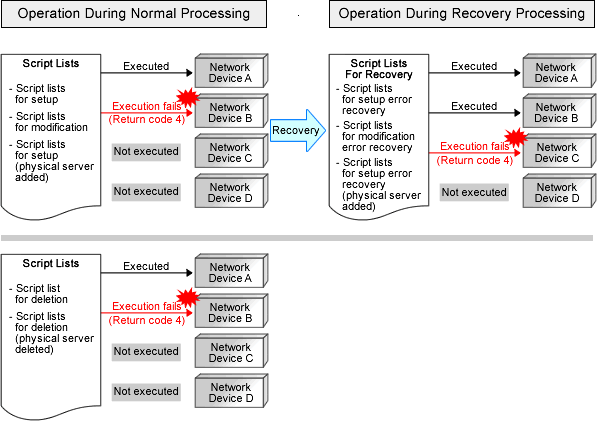This section explains how to create script files.
Script Structure
This section explains the structure of scripts.
The process from establishing to releasing a telnet/ssh connection with the target network device is written in scripts.
The basic structure is shown in the following figure.
Variable information is converted using information from the parameter file and DB and defined as a variable.
Establishes a telnet connection to the admin LAN IP address defined in the variable.
Sends the login account defined in the variable.
Sends the login password defined in the variable.
If command files exist
Send the content of the command file line by line.
If command files do not exist
Executes the process of sending and receiving commands in a script.
If the command ends normally, the return value "normal" is set.
If the command process ends abnormally, the return value "error" is set.
Send the variable (logout string).
Disconnect the telnet connection.
Note
Define the process from connection to disconnection in the script.
Variable Information Usable in Scripts
Variables used in scripts are defined in the variable definition section.
Variables including variable information are defined between the reserved variables "%Unm_DefineStart%" and "%Unm_DefineEnd%" as follows.
# %Unm_DefineStart% |
Reserved variable names consist of character strings with "Unm" as a prefix and alphanumeric characters and an ampersand ("&"), underscores ("_"), and hyphens ("-"). "&" in a character string is a symbol utilized to split a character string into a meaningful string such as an L-Server name and a network resource name.
Reserved variable names which can be used in scripts are shown in the following table.
Information Type | Variable Name | Usage After Conversion |
Variable information (beginning) | %Unm_DefineStart% (*1) | Specify the beginning of the range for variable conversion in a script. |
Variable information (end) | %Unm_DefineEnd% (*1) | Specify the end of the range for variable conversion in a script. |
Command file name | %Unm_CommandFileName% (*2) | Command file name |
VLAN-ID | %Unm_VlanId% (*3) | VLAN-ID value |
VLAN-ID | %Unm_VlanId&Network Resource Name% (*3) | VLAN-ID value |
Admin IP address | %Unm_MyLoginIp% | IP address used for logging in to the target device via SSH/TELNET/FTP |
Login account 1 | %Unm_MyLoginAccount1% | Account name used for logging in to the target device via SSH/TELNET/FTP |
Login account 2 | %Unm_MyLoginAccount2% | Account name used for logging in to the target device via FTP |
Login password 1 | %Unm_MyLoginPass1% | SSH/TELNET password for logging in to the target device |
Login password 2 | %Unm_MyLoginPass2% | FTP password for logging in to the target device |
Admin password 1 | %Unm_MyAdminPass1% | Password to change to admin privileges of the target device |
Admin account | %Unm_MyAdminAccount% | Admin account of the target device |
Admin password 2 | %Unm_MyAdminPass2% | Admin password of the target device |
Login port | %Unm_LoginPort% | SSH/TELNET port for logging in to the target device |
FTP admin IP address | %Unm_FtpLoginIp% | IP address for logging in from the target device via FTP |
FTP login port | %Unm_FtpLoginPort% | Port used for logging in from the target device via FTP |
FTP login account | %Unm_FtpLoginAccount% | Account name for logging in from the target device via FTP |
FTP login password | %Unm_FtpLoginPass% | Password for logging in from the target device via FTP |
Adjoining L2 switch 1 | %Unm_SwNode1% (*4) | Network device name of the adjoining L2 switch connected to the physical rack server NIC |
Adjoining L2 switch 2 | %Unm_SwNode2% (*4) | Network device name of second adjoining L2 switch connected to physical rack server redundant NIC |
Adjoining L2 switch port 1 | %Unm_SwPort1% (*4) | Port name of the second adjoining L2 switch connected to the physical rack server redundant NIC |
Adjoining L2 switch port 2 | %Unm_SwPort2% (*4) | Port name of second adjoining L2 switch connected to physical rack server redundant NIC |
Network device IPv4 address | %Unm_Ipv4&Sequential Number&Network Resource Name% (*5) | IPv4 address configured on the interface of the automatic configuration target device |
Network device IPv4 subnet | %Unm_Ipv4Subnet&Network Resource Name% | IPv4 subnet configured on the interface of the automatic configuration target device |
Network device IPv4 subnet mask | %Unm_Ipv4SubnetMask&Network Resource Name% | IPv4 subnet mask configured on the interface of the automatic configuration target device |
Network device IPv4 subnet mask length | %Unm_Ipv4SubnetMaskLength&Network Resource Name% | IPv4 subnet mask length configured on the interface of the automatic configuration device |
Network device IPv6 address | %Unm_Ipv6&Sequential Number&Network Resource Name% (*5) | IPv6 address configured on the interface of the automatic configuration target device |
Network device IPv6 prefix | %Unm_Ipv6Prefix&Network Resource Name% | IPv6 prefix configured on the interface of the automatic configuration target device |
Network device IPv6 prefix length | %Unm_Ipv6PrefixLength&Network Resource Name% | IPv6 prefix length configured on the interface of the automatic configuration target device |
VRID | %Unm_Vrid&Network Resource Name% | VRID configured on the interface of the automatic configuration target device |
L-Platform name | %Unm_LplatformName% | Name of the L-Platform performing processing |
L-PlatformID | %Unm_LplatformId% | Resource ID of the L-Platform performing processing |
Firewall name | %Unm_FirewallName% | Name of the firewall processing the L-Platform |
Firewall resource ID | %Unm_FirewallId% | Resource ID of the firewall processing the L-Platform |
Server load balancer name | %Unm_SlbName% | The name of the processed SLB on the L-Platform |
The server load balancer resource ID | %Unm_SlbId% | The resource ID of the processed SLB on the L-Platform |
List of admin IP addresses of redundant network devices | %Unm_Group&Group Number% | List of admin IP addresses of the redundant network device corresponding to the group number of the script The group number specified in the script list |
Backup directory | %Unm_BackupDir% (*6) | Absolute path name of the backup directory |
Current setting information | %Unm_Present&Variable name% (*7) | The content of the variable name used in the most recent configuration |
Variable parameter specified by an infrastructure administrator | %Unm_Set_Variable_Character&Network_Resource_Name% | The value when a variable parameter excluding variable parameter limited by the system is specified in the interface configuration file |
*1: The scope of the script lines converted by the script which converts variable information
When %Unm_DefineStart% is defined, but %Unm_DefineEnd% is not defined
Lines from %Unm_DefineStart% to the last line of script files are considered as variable parameters to be converted.
When %Unm_DefineStart% is not defined, but %Unm_DefineEnd% is defined
Variable parameter conversion is not executed in the script file.
When that %Unm_DefineStart% and %Unm_DefineEnd% are multiply defined
Variable parameters between first %Unm_DefineStart% and %Unm_DefineEnd% from first line of file are the targets of variable parameter conversion.
*2: Command file name
In variable information of the command file name, configure the name added to "exec_discrimination number (8 - 10 digits)" before the command file name prescribed by the system.
When you use multiple command files in a script, it is necessary that variable parameters of the script are written as variable information of the command file name + n (n is a sequential number).
Example "%Unm_CommandFileName%1.cli" |
*3: VLAN-ID value of network resources
VLAN-ID values that can be used as variable information differ depending on the device to be configured automatically.
When you use the VLAN-ID value of a network resource as variable information, specify it in the following format in the script and the value will be resolved by the system.
When the automatically configured device is an L2 switch
VLAN-ID value : %Unm_VlanId%
Specify the VLAN-ID configured for the network resource as variable information.
When the automatically configured device is a firewall
VLAN-ID value: %Unm_VlanId & Network resource name (up to 32 characters)%
The VLAN-ID configured in the network resource corresponding to the specified network resource name is configured as variable information.
For the network resource name, the name of the network resource in the segment used by the L-Platform can be used.
When the automatically configured device is a server load balancer
VLAN-ID value: %Unm_VlanId & Network resource name (up to 32 characters)%
The VLAN-ID configured in the network resource corresponding to the specified network resource name is configured as variable information.
For the network resource name, the name of the network resource in the segment where the server load balancer is located can be used.
*4: Reserved variable names when physical rack servers have redundant NICs
For a physical rack server with redundant NICs, the reserved variable names are as follows:
Figure F.4 Reserved Variable Names for Physical Rack Mount Servers with Redundant NICs

*5: Sequential numbers
Ensure that specified sequential numbers are the values corresponding to the IPv4/IPv6 addresses for the desired purpose.
Assign sequential numbers for each purpose to the IPv4/IPv6 addresses required by network devices, such as physical IPv4/IPv6 addresses for active units and virtual IPv4/IPv6 addresses for standby units.
Specify the mapping of the IPv4/IPv6 addresses for each purpose and assign sequential numbers in the following elements in the interface configuration file:
The IPv4Address element
The IPv6Address element
*6: Backup directory
Parameters in the following definition files are configured as a backup directory name.
Storage Location of the Definition File
[Windows Manager]
Installation_folder\SVROR\Manager\etc\customize_data\manager_backup.rcxprop
[Linux Manager]
/etc/opt/FJSVrcvmr/customize_data/manager_backup.rcxprop
Parameter Format of Definition Files
ruleset_backup_dir=backup directory
backup directory: specify the backup directory name using an absolute path.
If this parameter is not specified, the following backup directory is specified by default.
[Windows Manager]
Installation_folder\SVROR\Manager\var\lserver_repair\ruleset_backup
[Linux Manager]
/var/opt/FJSVrcvmr/lserver_repair/ruleset_backup
*7: Current setting information
It is possible to obtain information from when creating resources for firewalls and server load balancers, until those resources are deleted.
When two or more types of scripts are executed during creation or modification of resources of firewalls or server load balancers, the variable name used by the script that was last executed can be used as the current setting information.
When using the current setting information, it is not possible to configure different values for individual scripts or to use different variable information names for individual scripts in the script list. The variable information name and value must be the same throughout the script list.
The variable names which can be specified for "variable name" of this reserved variable are the following reserved variable names, and user-defined variable names stated in the parameter file.
Information Type | Reserved Variable Name |
Command file name | %Unm_CommandFileName% |
VLAN-ID | %Unm_VlanId&Network Resource Name% |
L-Platform name | %Unm_LplatformName% |
L-Platform resource ID | %Unm_LplatformId% |
Firewall name | %Unm_FirewallName% |
Firewall resource ID | %Unm_FirewallId% |
Server load balancer name | %Unm_SlbName% |
The server load balancer resource ID | %Unm_SlbId% |
List of admin IP addresses of redundant network devices | %Unm_Group&Group Number% |
Current setting information varies depending on how many times automatic configuration was performed.
"None" indicates that the variable name will not be converted because there is no value.
Number of Times Executed | Variable Name | Information of %Unm_Present & Variable name% | Variable Name Information |
First time | A | None | 1 |
B | None | 2 | |
C | None | 3 | |
Second time | A | 1 | 11 |
B | 2 | 2 | |
C | 3 | None | |
Third time | A | 11 | 11 |
B | 2 | 2 | |
C | None | 1 |
Information
Reserved variable names are written in the following locations.
Any place in a command file
In the "node" operand and "param" operand in script lists
Between the "%Unm_DefineStart%" line and "%Unm_DefineEnd%" line in a script
When you do not use a sample script (as in cases where an infrastructure administrator creates their own new script), specify variable information which is usable in command files and scripts using character strings enclosed by % as in "% %". The maximum length of a variable information string is 128 characters.
In the character string enclosed by %, alphanumeric characters, underscores ("_"), and hyphens ("-") can be used. "Unm_" is a reserved variable name, so it cannot be included in variable names specified by users.
Variable information can be written in the following locations.
Any place in a command file
Between the "%Unm_DefineStart%" line and "%Unm_DefineEnd%" line in a script
Operation when Variable Information Conversion in a Script Fails
If conversion of variable information fails, variable information parameters are not converted and the script is executed.
If variable information in the command file is a character string before conversion, the script will not send that command or any associated commands to the network device.
A script execution error is not returned just because the conversion of variable information fails.
If conversion of the following variable information related with the adjoining L2 switch fails, the script is not executed and an error is returned because there is a problem when constructing information of the network device.
%Unm_SwNode1%
%Unm_SwNode2%
%Unm_SwPort1%
%Unm_SwPort2%
Return Codes Used by Scripts
The results of script execution are determined to be normal or abnormal based on their return code.
Based the code returned by a script, the process ends normally or recovery action is executed.
Return codes used for scripts are as follows.
Return Code | Return Code Meaning |
0 | Processing of the script ended normally. |
4 | An error occurred in script execution, but the script can be executed again. (Connection closed or connection time out) |
6 | An error occurred in script execution, but the script can be executed again. (An error occurred before reflection of the definition on the network device) |
8 | An error occurred in script execution, and the script cannot be executed again. (Errors other than the above)
|
Confirming Results of Script Execution
In order to check the progress of script execution and any errors in a script, create the script so that process content is logged to an arbitrary file.
Refer to the contents of the output log file to confirm results of script execution.
Sample scripts generate logs in the folder where rulesets are placed to provide reference information for infrastructure administrators.
When checking the content, copy the log file to an arbitrary user directory and then open the copied log file.
For the name of the log file output by sample scripts, refer to "G.5.5 Log Files of Sample Scripts".
Note
The above log file is used when infrastructure administrators check script action. Use of this log file by tenant users and administrators has not been considered. Accordingly, there is no protection between tenants.
Do not perform standard output or standard error output of script execution results, except for script files used by the rulesets for operations. If scripts which perform standard output or standard error output are used, automatic network device configuration may be aborted.
To perform standard output and standard error output of script execution results using the script files used by a ruleset for operations, it is necessary to specify the same processing method as the one used in the sample script. If you create and use an original processing method for standard output and standard error output, the execution result of the scripts for operations cannot be obtained and L-Platform operations may fail.
Operation when Script Executions Results are Abnormal
When there are abnormal script execution results when executing a script list, the operations that follow vary depending on the type of script list and the specifications of the definition file.
Script Lists | Operation when Script Executions Results are Abnormal | |
|---|---|---|
SCRIPT_EXECUTION_MODE=continue | SCRIPT_EXECUTION_MODE=stop | |
| Execution of the script is canceled. If a script for recovery has been prepared, the script for recovery is executed. (*1) | |
| Execution of the script is continued. | Execution of the script is canceled. |
| Execution of the script is continued, without canceling execution of the script for recovery. | Execution of the script for recovery is canceled. When the execution results are not abnormal, the script for recovery will be executed for all network devices. |
*1: There are no scripts for recovery in script lists for operations.
For details of the specified parameters and possible parameter values of the definition file "SCRIPT_EXECUTION_MODE", refer to "F.7 Network Device Automatic Configuration and Operation Definition Files".
The operations when executing scripts change depending on the specified values in the definition file "SCRIPT_EXECUTION_MODE". Decide the value to specify in "SCRIPT_EXECUTION_MODE" based on the specifications of the scripts being used.
Figure F.5 Example Script Operation not Reliant on SCRIPT_EXECUTION_MODE Specifications

Figure F.6 Example Script Operation for SCRIPT_EXECUTION_MODE=continue

Figure F.7 Example Script Operation for SCRIPT_EXECUTION_MODE=stop

Execution Conditions for Scripts for Recovery
This section explains the execution conditions for scripts for recovery.
When "SCRIPT_EXECUTION_MODE=continue" is specified in the definition file
When an error occurs in a script for configuration or modification, the script for recovery will be executed for the network device the script was being executed on. Execution of the script for recovery is determined based on the return code of the script for configuration or modification.
Return Code of the Script for Configuration or Modification | Application of the Script for Recovery | Status of the Network Device after Script Execution |
|---|---|---|
0 | The script for recovery is executed | Unchanged |
4 | The script for recovery is executed | Unchanged |
6 | The script for recovery is not executed | Unchanged |
8 | The script for recovery is not executed | It is placed into maintenance mode. |
When "SCRIPT_EXECUTION_MODE=stop" is specified in the definition file
When an error occurs in a script for configuration or modification, all scripts in the script list for recovery will be executed.
For details of the specified parameters and possible parameter values of the definition file, refer to "F.7 Network Device Automatic Configuration and Operation Definition Files".